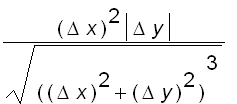¡@
Tangent Planes and Linear Approximations
Recall that the equation of the tangent line to the curve
at the point (
) is given by
, where
= f ' ( a )
provided that
is differentiable at
. Moreover, the linear function
+ f ' ( a )(
)
is a good approximation of
near
, in the sense that
.gif)
Now consider a surface
given by the equation
and let
be a point on
. Does
has a tangent plane at
? If so, what is the equation of the tangent plane ?
¡@
Let's consider the second question first. Suppose that
has a tangent plane at
and let be a curve on
passing through
. If
is the tangent line to
at
then must lie on this tangent plane, as shown in the animation below.
In particular, let
and
be the curves obtained by intersecting the vertical planes
and
with the surface
. Then the point
lies on both
and
. Let
and
be the tangent lines to the curves
and
at the point
. Then the tangent plane to the surface
is the plane that contains both tangent lines
and
.
![[Maple Plot]](images/suppl_TangentPlanes42.gif)
In terms of vector functions,
and
have the parametric equations
and
,
respectively .
¡@
so that
and
have direction vectors
u = (
) and v = (
),
respectively .
Hence a normal vector of the tangent plane is given by the cross product
u x v = (
)
so the equation of the tangent plane is given by
*(x-x[0])+f[y](x[0],y[0])*(y-y[0...](images/suppl_TangentPlanes52.gif)
¡@
So we conclude that if
has a tangent plane at
then
must have first order partial derivatives at (
).
Here we consider the tangent plane to the paraboloid
at (
).
Let
, we have
,
and the equation of the tangent plane must be

The graph above shows that the more we zoom in, the flatter the graph appears and the more it resembles its tangent plane.
In the graph below we corroborate this impression by zooming in toward the point (
) on a contour graph of
. Notice that the more we zoom in, the more the level curves look like equal spaced parallel lines, which is characteristic of a plane.
¡@
![[Maple Plot]](images/suppl_TangentPlanes67.gif)
![[Maple Plot]](images/suppl_TangentPlanes68.gif)
¡@
Therefore, in the view of visual evidence in the graphs above, the linear function
*(x-a)+f[y](a,b)*(y-b)+f(a,b)](images/suppl_TangentPlanes69.gif)
is a good approximation to
when (
) is near (
).
¡@
The function
is called the linearization of
at (
).
However, the existence of first partial derivatives is not sufficient to have tangent planes.
Here we provide an example that the function does have first partial derivatives but does not have a tangent plane :
Let
for all (
) except (
) and
.
We have
and
.
From the previous discussion, we know that if the surface
has a tangent plane at (
) then the equation of the tangent plane must be
. However, the tangent line of the curve obtained by intersecting the vertical planes
with the surface does not lie on
.
![[Maple Plot]](images/suppl_TangentPlanes87.gif)
We can confirm this by its contour graphs. As we zoom in toward (
) on a contour graph of the function
, the level curves do not look like equally spaced parallel lines at all.
![[Maple Plot]](images/suppl_TangentPlanes90.gif)
![[Maple Plot]](images/suppl_TangentPlanes91.gif)
When does the surface
have a tangent plane at (
) ?
We say
is differentiable at (
) iff
![limit(abs(f(x[0]+Delta*x,y[0]+Delta*y)-L(x[0]+Delta...](images/suppl_TangentPlanes96.gif)
where
.
Theorem
Suppose that
has continuous first partial derivatives at (
) then
is differentiable at (
).
If f is differentiable at (
) iff the linearization at (
)
*(x-x[0])+f[y](x[0],y[0])*(...](images/suppl_TangentPlanes104.gif)
is a good approximation of
near (
), that is,
is close to
when (
) is close enough to (
).
In particular,
approaches to
as (
) approaches to (
).
Hence, if
is differentiable at (
) then
is continuous at (
).
For the function
, we have
,
are continuous for all
in R . Hence,
is differentiable for all
in R. In fact, if
is a polynomial, then
is differentiable for all
in R .
For the function
for all (
) except (
) and
, we see that
=

and that
does not exist (Exercise !). Hence, g is not differentiable at (
).
Note that both
and
are not continuous at (
).
We shall see later that if
has continuous first partial derivatives at (
) then the surface
have a tangent plane at (
).
![[Maple Plot]](images/suppl_TangentPlanes25/suppl_TangentPlanes25_001.jpg)
![[Maple Plot]](images/suppl_TangentPlanes63.gif)
![[Maple Plot]](images/suppl_TangentPlanes64.gif)